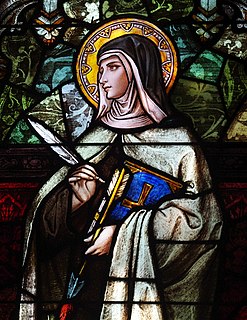Life
Natalis was in office as archbishop from 746 to 747, [1] but also the years 750 to 751 [2] or 740 to 741 are proposed by scholars.
Almost nothing is known about the life and the episcopate of Natalis. The main source of information about his episcopate was a gravestone which was placed in the church of San Giorgio al Palazzo in Milan and which was still extant in the 16th century. From the copies of such gravestone it is known that Natalis governed the church of Milan for fourteen months, that he died at 72 and that he founded the church of San Giorgio, having obtained a donation, probably from Ratchis, king of the Lombards. [1]

San Giorgio al Palazzo is a baroque-style, Roman Catholic church in central Milan, region of Lombardy, Italy.

Ratchis was the Duke of Friuli (739–744) and King of the Lombards (744–749). His father was Duke Pemmo. His Roman wife was Tassia. He ruled in peace until he besieged Perugia for reasons unknown. Pope Zachary convinced him to lift the siege, and he abdicated and entered the abbey of Montecassino with his family. After the death of Aistulf in 756, he tried once again to reign over the Lombards, but he was defeated by Desiderius and retired to a cloister.
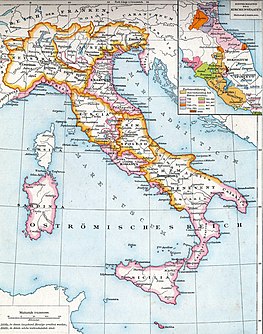
The Lombards or Longobards were a Germanic people who ruled most of the Italian Peninsula from 568 to 774.
Other traditional information about his life, such as his surname Marinoni and his scholarship in Latin and Hebraic, have no historical basis. [2]

Latin is a classical language belonging to the Italic branch of the Indo-European languages. The Latin alphabet is derived from the Etruscan and Greek alphabets and ultimately from the Phoenician alphabet.
Natalis was buried in the nave of the church of San Giorgio al Palazzo. His relics were translated into the main altar of the same church in the 18th century by archbishop Giuseppe Pozzobonelli, and are still venerated there. [2] His feast day is May 13 in the Roman Rite and May 9 in the Ambrosian Rite. [3]

Giuseppe II Pozzobonelli was an Italian Cardinal and the Archbishop of Milan from 1743 to 1783.

The Roman Rite is the most widespread liturgical rite in the Catholic Church, as well as the most popular and widespread Rite in all of Christendom, and is one of the Western/Latin rites used in the Western or Latin Church. The Roman Rite gradually became the predominant rite used by the Western Church. Many local variants, not amounting to distinctive Rites, existed in the medieval manuscripts, but have been progressively reduced since the invention of printing, most notably since the reform of liturgical law in the 16th century at the behest of the Council of Trent (1545–63) and more recently following the Second Vatican Council (1962–65).

The Ambrosian Rite, also called the Milanese Rite, is a Catholic Western liturgical rite. The rite is named after Saint Ambrose, a bishop of Milan in the fourth century. The Ambrosian Rite, which differs from the Roman Rite, is used by some five million Catholics in the greater part of the Archdiocese of Milan, Italy, in some parishes of the Diocese of Como, Bergamo, Novara, Lodi and in about fifty parishes of the Diocese of Lugano, in the Canton of Ticino, Switzerland.
This page is based on this
Wikipedia article Text is available under the
CC BY-SA 4.0 license; additional terms may apply.
Images, videos and audio are available under their respective licenses.

Simplician was Bishop of Milan from 397 to 400 or 401 AD. He is honoured as a Saint in the Roman Catholic and Eastern Orthodox Churches and his feast day is August 14.

Benedict was Archbishop of Milan from c. 685 to c. 732. He is honoured as a saint in the Catholic Church.

Glycerius was Archbishop of Milan from 436 to 438. He is honoured as a Saint in the Catholic Church and Eastern Orthodox Church.

Castritian was Bishop of Milan in mid 3rd-century. He is honoured as a Saint in the Catholic Church and his feast day is on December 1.

Monas was Bishop of Milan from the end 3rd-century to early 4th-century. He is honoured as a Saint in the Catholic Church and his feast day is on October 12.
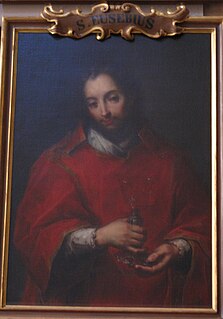
Eusebius was Archbishop of Milan from 449 to 462. He is honoured as a saint and his feast day is 12 August.
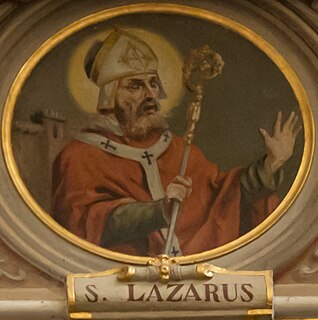
Lazarus was Archbishop of Milan from 438 to 449 AD. He is honoured as a saint in the Catholic Church and his feast day is February 11.

Gerontius was Archbishop of Milan from 462 to 465. He is honoured as a Saint in the Catholic Church and his feast day is 5 May.
Benignus was Archbishop of Milan from 465 to 472. He is honoured as a Saint in the Catholic Church and his feast day is September 20.

Protasius was Archbishop of Milan. He is honored as a saint in the Catholic Church, with his feast day celebrated on 24 November, the day of his death.

Mirocles was Bishop of Milan from before 313 to c. 316. He is honoured as a Saint in the Catholic Church and his feast day is on December 3.

Caius was Bishop of Milan in early 3rd-century. He is honoured as a Saint in the Catholic Church and his feast day is on September 27.

Anathalon was the first recorded Bishop of Milan and lived at the end 2nd-century or early 3rd-century. He is honoured as a Saint in the Catholic Church and his feast day is on September 25 in Milan. A late tradition made him the first bishop of Brescia where his feast day is celebrated on September 24.
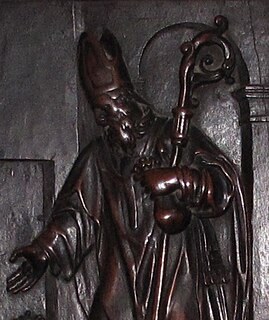
Theodorus I was Archbishop of Milan from 475 to 490. He is honoured as a saint in the Eastern Orthodox Church and Catholic Church, and his feast day is July 27.
Lawrence I was Archbishop of Milan from 490 to c. 511. He is honoured as a saint in the Catholic Church and his feast day is July 25.

Magnus was Archbishop of Milan from 518 to c. 530. He is honoured as a saint in the Catholic Church.

John the Good was Archbishop of Milan from c. 641 to 669. He is honoured as a Saint in the Catholic Church and his feast day is on January 15.

Mansuetus was Archbishop of Milan from 676 to 685. He is honoured as a saint in the Catholic Church.
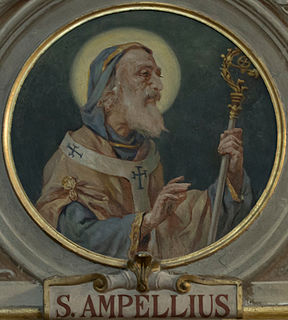
Ampelius was Archbishop of Milan from 671 to 676. He is honoured as a saint in the Catholic Church.

